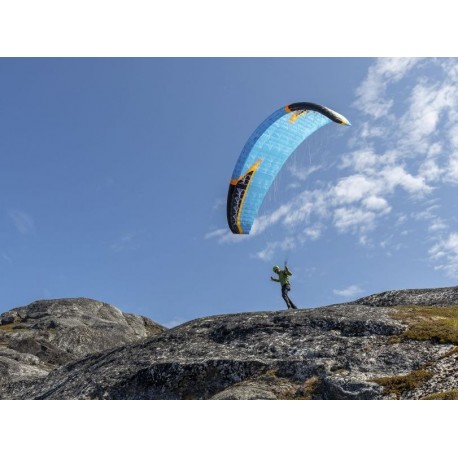Nav produktu
NIVIUK - SKIN 3
New
Forget everything you've seen and heard about single-surface gliders. The new Skin 3 brings together the best of two worlds, and for the first time a single-surface glider offers the characteristics and flying comfort comparable to a conventional paraglider.
PILOTS
"I have been a Skin fan since its inception. I appreciate this type of glider for Hike and Fly in high mountains. It allows committed take-offs that could not be done with another wing. I was lucky to try the latest Skin model in Greenland. I especially appreciate the evolution of this version regarding take-off quality, flight feel, simplicity and efficiency of the trim system, as well as landing. The glider rises more quietly over the head and allows easier control. In flight, the spinning sensation is very similar to that of a standard paraglider and the trim system offers real acceleration. In the wind, it keeps moving forward. Upon landing, I was even surprised by a real retention. The Skin is a true adventure companion to always have in the bag. "
Luc Hentsch
TECHNOLOGIES
3D Leading Edge
3DL technology is an adjustment of the fabric at the leading edge of the wing to control the ballooning and the creases that are generated by the curvature in this area. The leading edge is then divided into sub-panels which are sewn into each of the cells at the front of the wing. As a result, the leading edge of the wing is more evenly tensioned, which benefits the wing in performance and durability.
3D Pattern Cut Optimization
This technology seeks to implement the best orientation of the cloth on each panel according to its location on the leading edge. If the cloth pattern is correctly aligned with the load axes, the cloth suffers less deformation flight after flight, so the leading edge keeps its shape better and maintains its durability over time.
RAM Air Intake
The Ram Air Intake system is characterised by the arrangement of the air inlets, to ensure optimal maintenance of internal pressure across the the whole range of angles of attack.
Structured Leading Edge
The SLE is a rigid structure located at the leading edge of the wing that eliminates the need for old-fashioned mylar reinforcements in this area, thus reducing the weight and increasing the durability of the wing. The leading edge will also have better turbulence absorbing qualities.
Titanium Technology
Nitinol is a combination of 50% nickel and 50% titanium. This technology provides three outstanding benefits that increase the performance of the wing, compared to plastic rods.
SPECIFICATIONS
| 16 | 18 | 20 | |||
| CELLS | NUMBER | 45 | 45 | 45 | |
| ASPECT RATIO | FLAT | m2 | 5,5 | 5,5 | 5,5 |
| SURFACE | FLAT | m2 | 16 | 18 | 20 |
| PROJECTED | m | 13,52 | 15,21 | 16,9 | |
| SPAN | FLAT | m | 9,38 | 9,95 | 10,49 |
| CORD | MAX | m | 2,04 | 2,17 | 2,29 |
| LINES | TOTAL | m | 251 | 267 | 282 |
| MAIN | 2/3/2/2 | 2/3/2/2 | 2/3/2/2 | ||
| RISERS | NUMBER | 4 | A/B/C/D | A/B/C/D | A/B/C/D |
| ACCELERATOR | mm | 45 | 45 | 45 | |
| TOTAL WEIGHT IN FLIGHT | MIN-MAX | Kg | 60-85 | 70-90 | 85-110 |
| GLIDER WEIGHT | Kg | 2,2 | 2,4 | 2,6 | |
| CERTIFICATION | EN/LTF | 926-1 | B | B |
| Sertifikācija | EN B |







